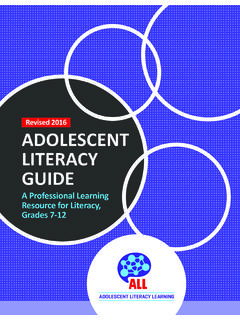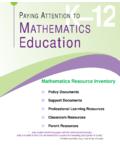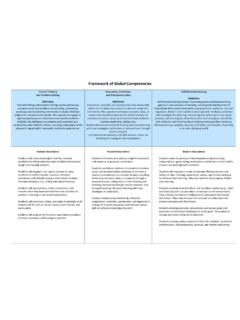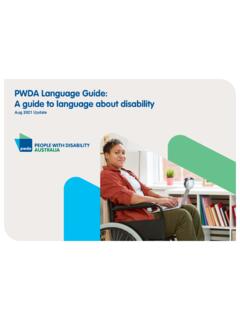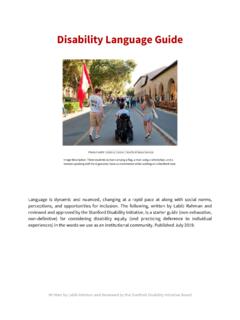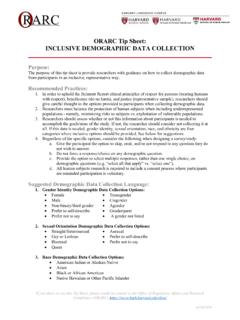Transcription of STEP User Guide Intial Assessment - EduGAINs
1 STEP. Initial Assessment Table of Contents STEP Initial Assessment Process 3. Welcoming New Families 4. Reception and Welcome Centres The Welcoming School Roles and Responsibilities Family Interview Student Profile Information Initial Assessment 9. Oral Assessment First language Writing and Reading Samples Early Literacy Tasks 13. Reading and Writing Assessment Tasks 17. Initial Placement on STEP Continua 18. Initial Mathematics Assessment 18. Recommendations for Support/Placement 20. Communicating 22. Designing Initial Reading and Writing Assessment Tasks 23.
2 STEP Initial Assessment Process The initial Assessment is a snapshot in time that provides baseline information about an English language learner's (ELLs) level of English proficiency and literacy development. Steps to English Proficiency (STEP) Initial Assessment is intended for all teachers and administrators who welcome and assess English language learners who are newly arrived in their schools. STEP supports the goal of the English language Learners ESL and ELD. Programs and Services: Policies and Procedures for Ontario Elementary and Secondary Schools, Kindergarten to Grade 12, 2007 by.
3 Describing procedures for reception, orientation, placement, and programming for ELLs describing procedures for initial Assessment of ELLs suggesting the roles of administrators, teachers, students, and families suggesting procedures for gathering information related to the initial Assessment of ELLs Purpose of Initial Assessment The initial Assessment is an important first step in determining an ELL's language proficiency and literacy development in English. It is an opportunity to develop a profile that includes the student's educational, cultural, and personal background.
4 The purpose of the initial Assessment is to determine: the student's language proficiency (oral, reading, and writing) and literacy development;. the student's mathematical skill level;. appropriate programming supports;. appropriate placement. This flow chart illustrates the initial Assessment process. Welcoming New Families Initial registration, Welcome, Orientation, and Family interview Initial Assessment Student oral interview Picture response First language writing and reading sample Initial determination of subsequent Assessment tasks Early Literacy Tasks Reading and Writing Assessment Tasks Initial Placement on STEP Continua Initial Mathematics Assessment Recommendations for Support/Placement Programs and support recommendations (elementary).
5 Placement and support recommendations (secondary). Communicating Communicate with all stakeholders to facilitate collaboration and next steps STEP Initial Assessment June 20123. Welcoming New Families School boards will develop protocols to define procedures and practices for welcoming English language learners and their families and providing them with appropriate orientation to the Ontario school system, in the first language of the students and their families, whenever possible. The protocol will include procedures for the admission of students in all grades, including Kindergarten regardless of level of English proficiency or prior schooling who arrive and need to begin school in Ontario at any time during the school year.
6 English language Learners ESL and ELD Programs and Services: Policies and Procedures for Ontario Elementary and Secondary Schools, Kindergarten to Grade 12, 2007. Reception and Welcoming Centres Some school boards have reception and welcoming centres where initial assessments are conducted and families receive information about the school board and community. In some boards the initial Assessment takes place in the school. The Welcoming School All schools should provide a reception and orientation program that ensures a warm welcome for ELLs and their families.
7 Creating a welcoming and inclusive school environment for ELLs and their families is a whole-school activity requiring the commitment of the administrative team, teachers, support staff, and other leaders within the school community. What a welcoming school looks like A welcoming school is an inviting place for students, staff, parents, and visitors. In a welcoming school: all staff are aware of and understand the process for receiving ELLs and their families information about community resources ( , libraries, community centres, adult ESL classes, places of worship, cultural organizations)
8 Is available in a variety of languages families are informed about the necessary documentation and process for school registration there is access to adult interpreters who can competently assist parents and help them fill out forms multilingual signs, in the languages of the community, are visible in the school Reception and orientation programs should include: a school reception team ( , the administrative team, office administrative assistant, ESL/ELD teacher, classroom teachers, guidance counsellor) as well as, an interpreter and/or settlement worker, as needed a designated place for the family and reception team to gather, meet, and share information orientation information about.
9 School calendar and routines content and use of student agenda school programs ESL and ELD programs and support school procedures in the event of absence, late arrival, or early leaving parental involvement ( , volunteering, Parent Council). community supports ( , settlement services, local adult ESL classes, and other community programs and resources). information about course selection (secondary). safe school policy student ambassadors 20124 STEP Initial Assessment June Welcoming New Families Roles and Responsibilities In creating a welcoming school environment, it is important that schools consider the needs of English language learners and their families.
10 Supervisory officers, school administrators, classroom teachers, ESL/ELD teachers, initial assessors, parents, and students all have a role to play. Supervisory Officers To support the work of school administrators, supervisory officers should: ensure the board's vision for reception, orientation, and Assessment is shared and understood demonstrate a commitment to an inclusive , respectful, equitable environment for ELLs by allocating and monitoring financial and human resources develop a board culture that promotes shared knowledge and shared responsibility for student success by assisting principals in recognizing and articulating the learning their staff needs to support ELLs monitor the board's implementation of the ELL policy Principals and Vice Principals To successfully implement a reception and welcoming protocol, school administrators should.

